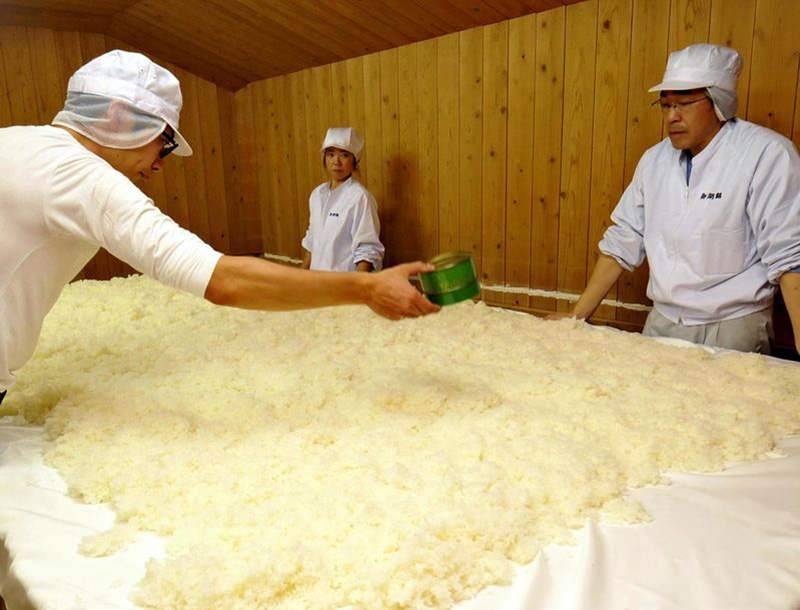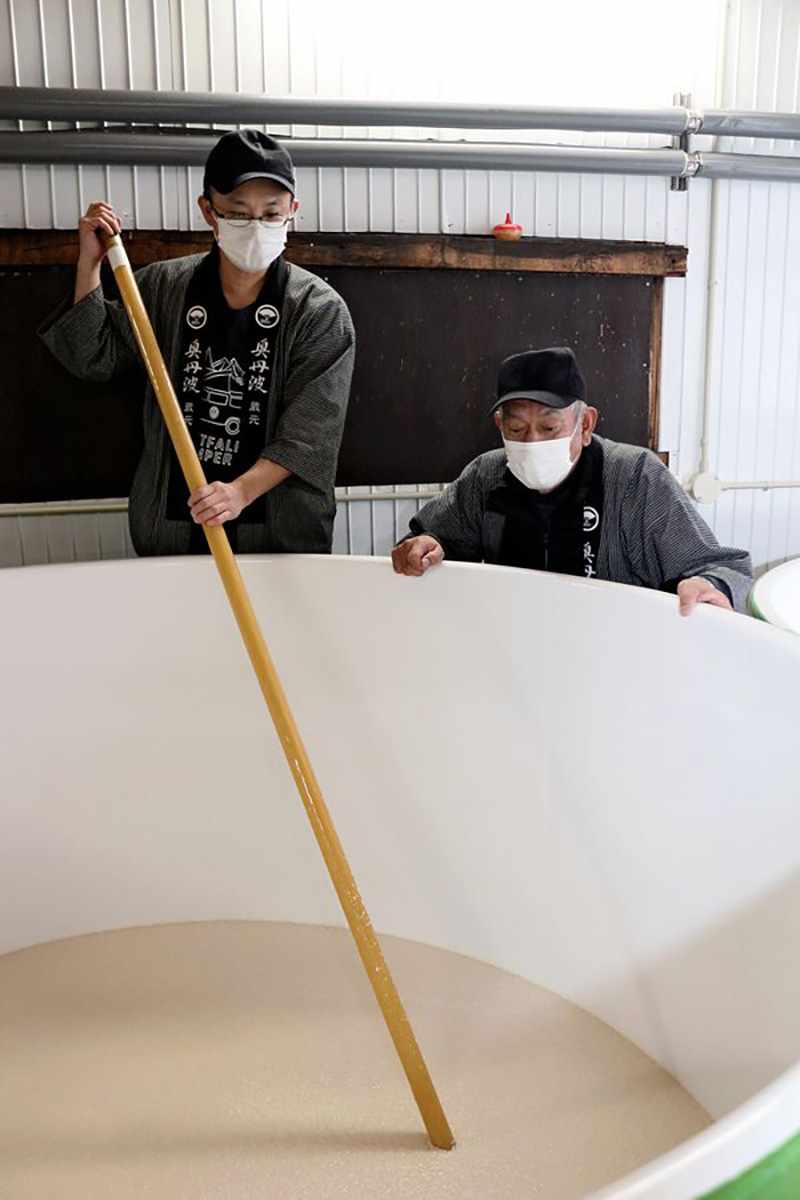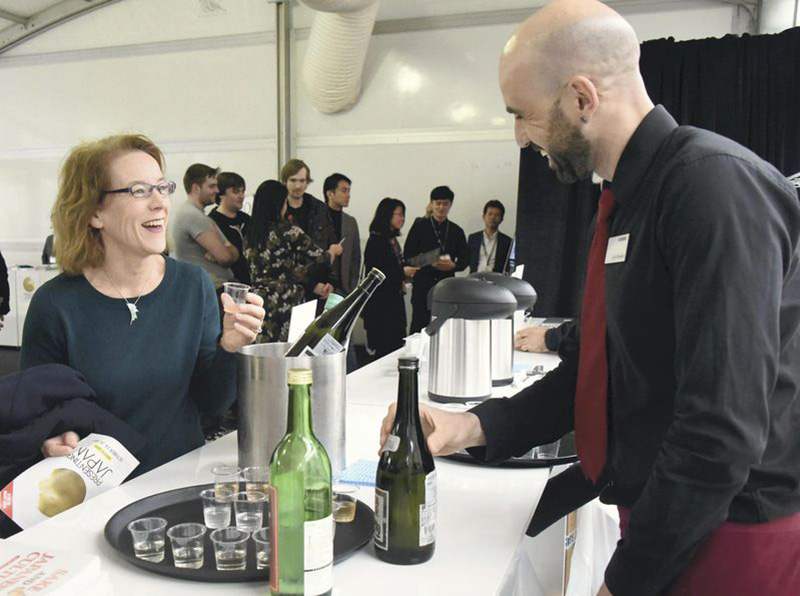
A worker at a sake brewery in Shimosuwa, Nagano Prefecture, sprinkles koji mold over steamed rice in an early stage of sake production.
13:32 JST, January 6, 2022
Japan’s sake industry is looking for ways to get the drink flowing again. Domestic shipments of the traditional beverage are diminishing in an era when more people are drinking less, with the novel coronavirus pandemic accelerating that trend. But in a contrasting trend abroad, sake exports have been steadily increasing.
In fact, sake exports hit record highs for at least 11 consecutive years through 2020. There is also a growing movement to have sake registered on UNESCO’s Intangible Cultural Heritage list.
Sake shipments peaked at 1.77 million kiloliters in fiscal 1973, but in fiscal 2020 they had fallen to less than a quarter of that amount, at just 410,000 kiloliters, according to the Japan Sake and Shochu Makers Association.

Toji sake brewers work at a brewery in Tamba, Hyogo Prefecture.
The drop-off was caused not only by the growing popularity of beer, low-malt happoshu brews and other competing products, but also the declining overall consumption of alcohol because large-scale company trips and parties became less common after the collapse of the bubble economy in the early 1990s.
The Great Hanshin Earthquake of 1995 also had a major negative impact, with heavy damage inflicted in the Nada area in Hyogo Prefecture, site of the country’s largest sake production base.
In part because of structural changes in the industry and consumption trends favoring the rediscovery of products from smaller breweries in regional areas, shipments of high-grade sake, such as junmai and ginjo types, had been steadily growing.

Guests at a Japan fair in London taste sake in this photo taken before the coronavirus pandemic began.
But that progress was virtually halted by the pandemic, which forced prolonged closures of izakaya pubs that serve sake at optimum conditions — which include friendly surroundings.
To compensate for the decline in consumption, retail prices went up, but that strategy has not worked well amid the circumstances of the pandemic.
Exports offer hope
Looking at the overseas market, the sake export value in 2020 was about ¥24.1 billion, an increase of 3% over the previous year and nearly three times the value of the ¥8.5 billion figure in 2010.
Data from the Agriculture, Forestry and Fisheries Ministry shows that the number of Japanese restaurants overseas increased from 24,000 in 2006 to 159,000 in 2021, enabling overseas tourists who enjoy sake during visits to Japan to continue drinking it at Japanese-style restaurants after returning home. And now, some breweries are directly expanding their overseas sales channels.
Izumibashi Sake Brewery Co. in Ebina, Kanagawa Prefecture, has been able to export to more than 10 countries across Asia and Europe after setting up a multi-language website using English, Chinese and Korean as well as Japanese.

The company is meeting global demand for at-home drinking among people who are cocooning through the pandemic. However, sake is still no match for French wine,with its export figures around ¥1 trillion.
The National Tax Agency said that Japanese sake’s share of the global alcohol market is still low.
To wash down washoku
Now the government is aiming to have sake registered on UNESCO’s Intangible Cultural Heritage list.
This list, launched in 2003, initially had a heavy focus on traditional performing arts, resulting in the registration of kabuki and noh theater.
In 2010, the gastronomic meal of the French was added to the list, bringing food culture into the spotlight. Washoku Japanese cuisine was added to the list in 2013, with the acknowledgement that “it is associated with an essential spirit of respect for nature.”
In October last year, “traditional sake brewing” was chosen for Japan’s newly established governmental system for registering intangible cultural assets, giving momentum to the movement to protect sake as one of the country’s cultural assets.
“Now that the government has demonstrated its stance to protect [traditional sake brewing] as a cultural asset, I believe its registration as part of the UNESCO intangible heritage will go smoothly,” said Miho Museum Director Isao Kumakura, who chaired a government’s review committee that was involved in washoku’s UNESCO recognition.
So far, items inscribed on UNESCO’s list in the field of alcoholic beverages include Belgian beer culture, a traditional winemaking method in Georgia and a traditional production technique using mare’s milk in Mongolia.
The history of sake brewing is documented in the classic Nara period (710-784) works Kojiki (Record of Ancient Matters) and Harima no Kuni Fudoki (a record of local customs in Harima Province). The original form of the current sake production method using koji mold was established during the Muromachi period (1336-1573).
“Sake is an indispensable part of Shinto rituals and traditional annual events, and has a deep connection with the traditional rural landscape of paddy fields,” said Yuichi Hashiba, president of Izumibashi Sake Brewery. “I hope people overseas become aware of the importance of sake, and that the Japanese public also gains a renewed appreciation of it.”
Koji, yeast team up
The essential ingredients for sake are rice and water. However, rice does not contain the kind of sugar that yeast turns into alcohol during fermentation. Teaming up koji mold with the yeast solves this problem, as the mold has enzymes that break rice starch down into sugar that the yeast can work with.
Master sake brewers called toji have handed down methods of cultivating their own koji, even though koji production — like sake-making overall — has been mechanized since the Meiji era (1868-1912).
In addition to sake, koji is also used to make shochu, awamori and mirin. An organization trying to preserve traditional sake production techniques has been seeking the collective registration of such uses of koji on the UNESCO list.
Through such efforts, it is hoped that appreciation of sake will deepen and grow, both in Japan and abroad.
"Society" POPULAR ARTICLE
-

M4.9 Earthquake Hits Tokyo, Neighboring Prefectures
-

Israeli Tourists Refused Accommodation at Hotel in Japan’s Nagano Pref., Prompting Protest by Israeli Embassy and Probe by Prefecture
-

M7.5 Earthquake Hits Northern Japan; Tsunami Waves Observed in Hokkaido, Aomori and Iwate Prefectures
-

Tsukiji Market Urges Tourists to Avoid Visiting in Year-End
-

High School in Kyoto Says Students Shoplifted during Recent School Trip to Bali, Indonesia
JN ACCESS RANKING
-

Tokyo Economic Security Forum to Hold Inaugural Meeting Amid Tense Global Environment
-

Keidanren Chairman Yoshinobu Tsutsui Visits Kashiwazaki-Kariwa Nuclear Power Plant; Inspects New Emergency Safety System
-

Imports of Rare Earths from China Facing Delays, May Be Caused by Deterioration of Japan-China Relations
-

University of Tokyo Professor Discusses Japanese Economic Security in Interview Ahead of Forum
-

Japan Pulls out of Vietnam Nuclear Project, Complicating Hanoi’s Power Plans























